Wine Industry Statistics 2024 – By Country, Region, Demographic and Wine Exports
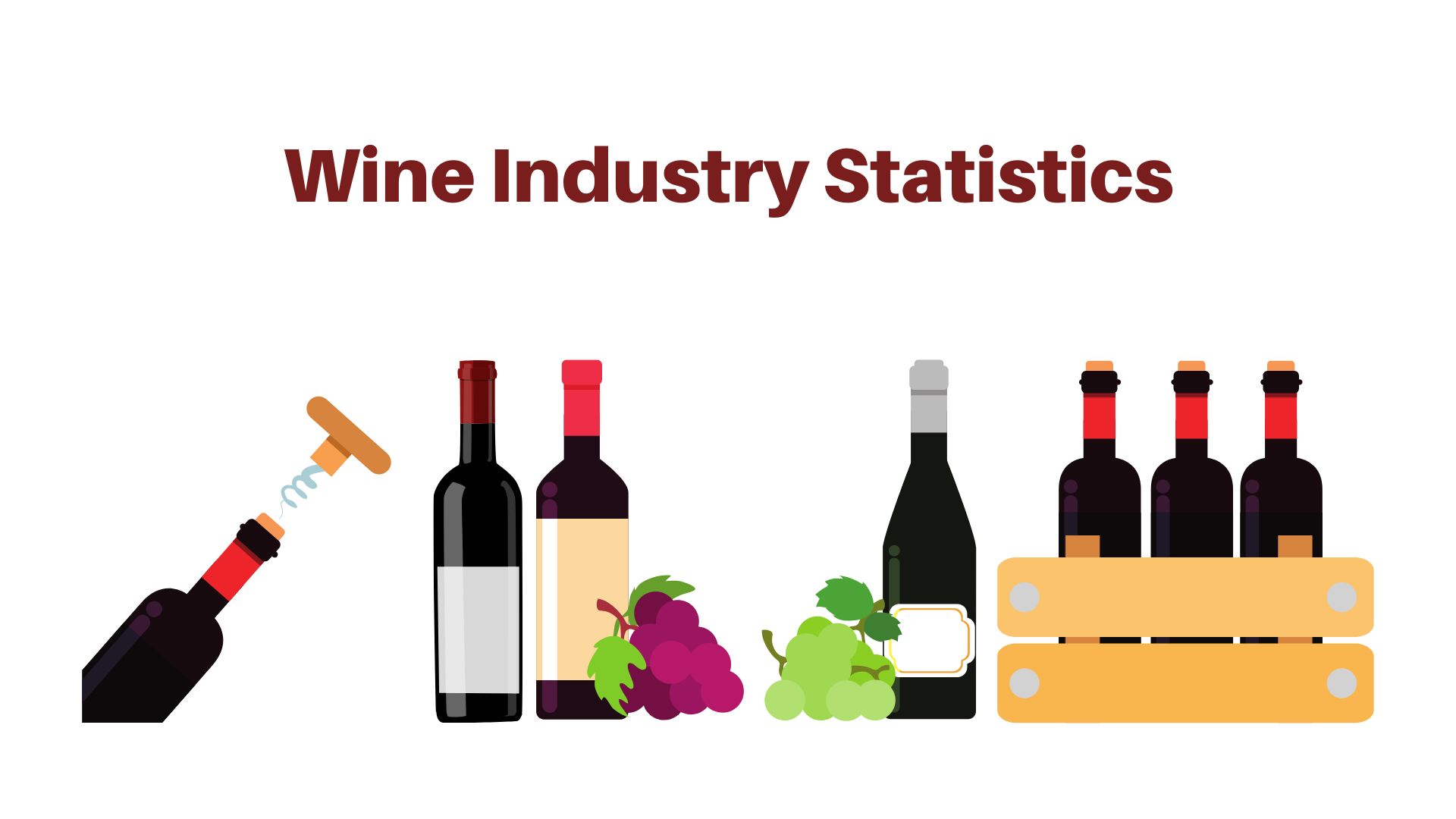
Page Contents
- Introduction
- Editor’s Choice
- Facts About the Wine Industry
- What Refers To Wine?
- Types Of Wines Around The World
- Benefits Of Drinking Red Wine
- General Wine Industry Statistics
- By Wine Exports
- By Country
- By Region
- By Type
- By Per Capita
- By Demographics
- By Coverage
- By Sales Channels
- By Supplies
- Wines Industry Statistics For Wine
- Trends In the Wine Industry
- Recent Developments In the Wine Industry
- Conclusion
Introduction
Wine Industry Statistics: Exploring the wine industry statistics unveils a dynamic and evolving landscape shaped by consumer preferences, economic trends, and global market dynamics. With the global wine market witnessing significant growth in recent years, the data presents compelling insights into this thriving industry.
In 2021, the global wine market was valued at approximately 320 billion USD, reflecting the substantial economic impact of wine production and consumption worldwide. Moreover, the market is projected to grow at a Compound Annual Growth Rate (CAGR) of 5.8%, reaching an estimated value of 23.59 billion USD by 2027.
This growth is driven by various factors, including increasing disposable income, changing consumer tastes, and expanding wine production regions. Furthermore, the wine industry employs millions of people globally, contributing to job creation and economic development in wine-producing regions. Through comprehensive analysis of wine industry statistics, we can gain valuable insights into market trends, consumer behavior, and opportunities for growth within this dynamic sector.
Editor’s Choice
- After the pandemic, 70% of digital alcohol sales include wine sales globally, indicating a significant shift towards online wine purchasing.
- The United States of America produced around 773 million gallons of wine in 2021, showcasing its prominent role in wine production.
- The global price range of wine ranging from USD 10 to USD 15 constitutes 39.1% of the market, reflecting consumer preferences for mid-range wines.
- As of 2022, the Asian wine market amounts to USD 52.66 billion, highlighting the region's growing significance in the global wine industry.
- Italy's wine market is projected to grow at a Compound Annual Growth Rate (CAGR) of 4.3%, driven by the easy availability of grapes for wine production.
- The consumption of wine in the United States reached 33.1 million hectoliters in 2021, emphasizing its status as a leading consumer of wine globally.
- It is forecasted that the sparkling wine segment will dominate the wine market with a growth rate of 8.5% by 2032, indicating shifting consumer preferences towards sparkling wines.
- Comparing the total European population, the per-person revenue in the wine segment is USD 176.10 as of 2022, highlighting the region's substantial wine consumption.
- Portugal ranks at the top for exporting the maximum liters of wine per capita, with 51.9 liters exported per person.
- In Europe, the average volume of wine consumed per person is 15.09 liters as of 2022, indicating the region's significant wine consumption habits.
- The global wine industry is expected to reach an estimated USD 434.6 billion by 2027, underscoring its economic significance on a global scale.
You May Also Like To Read
- Pet Ownership Statistics
- Bicycle Industry Statistics
- Christmas Spending Statistics
- Coffee Industry Statistics
- Fashion Industry Statistics
- Tea Statistics
- Coca-Cola Statistics
- Hotel Industry Statistics
- Home Improvement Industry Statistics
- Golf Industry Statistics
- Amazon Statistics
- Xiaomi Statistics
Facts About the Wine Industry
- The global wine market was valued at approximately USD 326.53 billion in 2020.
- European countries collectively account for about 60% of the global wine production.
- In 2021, the global online wine sales market was valued at USD 11.84 billion and is expected to reach USD 20.17 billion by 2026.
- Cabernet Sauvignon is the most widely planted grape variety in the world, covering over 840,000 acres of vineyards worldwide.
- France, Italy, and Spain together represent 81% of the total wine production in the European Union.
- Australia is the fourth-largest wine exporter globally, contributing 7% of the world’s total wine exports.
- Spain has the most extensive vineyard area globally, with over 2.5 million acres of vineyards.
- In 2020, e-commerce sales represented 19% of global wine retail sales, up from 8% in 2019.
- There are more than one million vineyards around the world, accounting for approximately 10 million acres of land.
- In 2020, Wine consumption in the United States accounted for approximately 3.79 billion liters.
What Refers To Wine?
The wine is referred to as an alcoholic beverage extracted from fermented grapes. Moreover, it is also referred to as a mostly agriculturally developed product because of the fermentation process. Sugar is consumed by Yeast in the grapes which are converted to ethanol and carbon dioxide which releases heat during the process. Wine production started thousands of years ago. There are five biggest Wine companies in the globe with annual sales are Treasury Wine Estate ($2 billion), Constellation Brands ($16 billion), E and J Gallo ($50 billion), The Wine Group ($1 billion), and Vina Concha y Toro ($920 million).
Types Of Wines Around The World
Red Wines
These wines are made from black grapes fermented using grape skins, seeds, and Stems. Red wines are recommended to be drunk at room temperature. Moreover, these wines can be drunk with BBQ ribs, pasta, Pizza, red meat, and burgers.
White Wines
These types of wines are made from black and white grapes. It is best paired with tacos, popcorn, chips, cheese, curries, and seafood.
Dessert Wines
Dessert wines are sweet wines that are normally sipped after a meal. They can be paired with biscotti, chocolate, vanilla pudding, and soft cheese.
Sparkling Wines
These types of wines are carbonated wines often called bubbly. They are made from white and black grapes along with added carbon dioxide. These wines are best paired with shrimp, popcorn, fresh fruit, and any light food.
Rose Wines
Rose wines are pink in color. They are made of black grapes. And can be paired with fish, fruits, salsa, and cheese.
Benefits Of Drinking Red Wine
- Reduces bad cholesterol.
- Regulates blood sugar.
- Treats regular cold problems.
- Improves memory sharpness.
- Red wine helps to keep the body slim.
- Improves digestive system.
- Reduces the cancer risk.
- Keep your heart fit and healthy.
- Red wine is rich in antioxidants.
General Wine Industry Statistics
- It is forecasted that the sparkling wine segment will dominate the Wine market globally with growth at 8.5% by the year 2032.
- The global price range of Wine ranging from USD 10 to USD 15 will be 39.1%.
- In the coming years, the Italian wine market is expected to grow at a CAGR of 4.3% being a reason – easy availability of grapes for wine production.
- By 2030, Wine industry statistics say that the global market is expected to increase by CAGR 6.1% reaching 825.5 billion.
- In the year 2021, the United States of America produced around 773 million gallons of wine.
- There are more than 11,000 wineries in the United States of America.
- As of 2021, Italy, France, and Spain were listed as the top three wine-producer countries.
- The worldwide wine consumption as of the year 2021 was 236 million hectoliters.
- Around 83.9% of the wine was produced in California considering the American wine market.
- The revenue of the global wine market is USD 340.8 billion whereas the global consumption is 236 million hl as per the wine industry statistics.
- The global leader of wine import in Germany.
- After the pandemic, 70% of digital alcohol sales include wine sales around the globe.
By Wine Exports
| Rank | Countries | Global Wine Market Revenue |
|---|---|---|
| 1 | France | US$13.1 billion (32.2% of total wine exports) |
| 2 | Italy | US$8.4 billion (20.7%) |
| 3 | Spain | US$3.5 billion(8.5%) |
| 4 | Chile | US$2 billion (4.8%) |
| 5 | Australia | US$1.7 billion (4.2%) |
| 6 | United States | US$1.5 billion (3.6%) |
| 7 | New Zealand | US$1.4 billion (3.4%) |
| 8 | Germany | US$1.2 billion(2.9%) |
| 9 | Portugal | US$1.1 billion (2.7%) |
| 10 | Argentina | US$853.3 milllion (2.1%) |
| 11 | South Africa | US$750.4 million (1.8%) |
| 12 | United Kingdom | US$6425 million (1.6%) |
| 13 | Belgium | US$643.3 million (1.6%) |
| 14 | Netherlands | US$598.3 million (1.5%) |
| 15 | Singapore | US$596.4 million (1.5%) |
(Source: World's Top Exports)
By Country
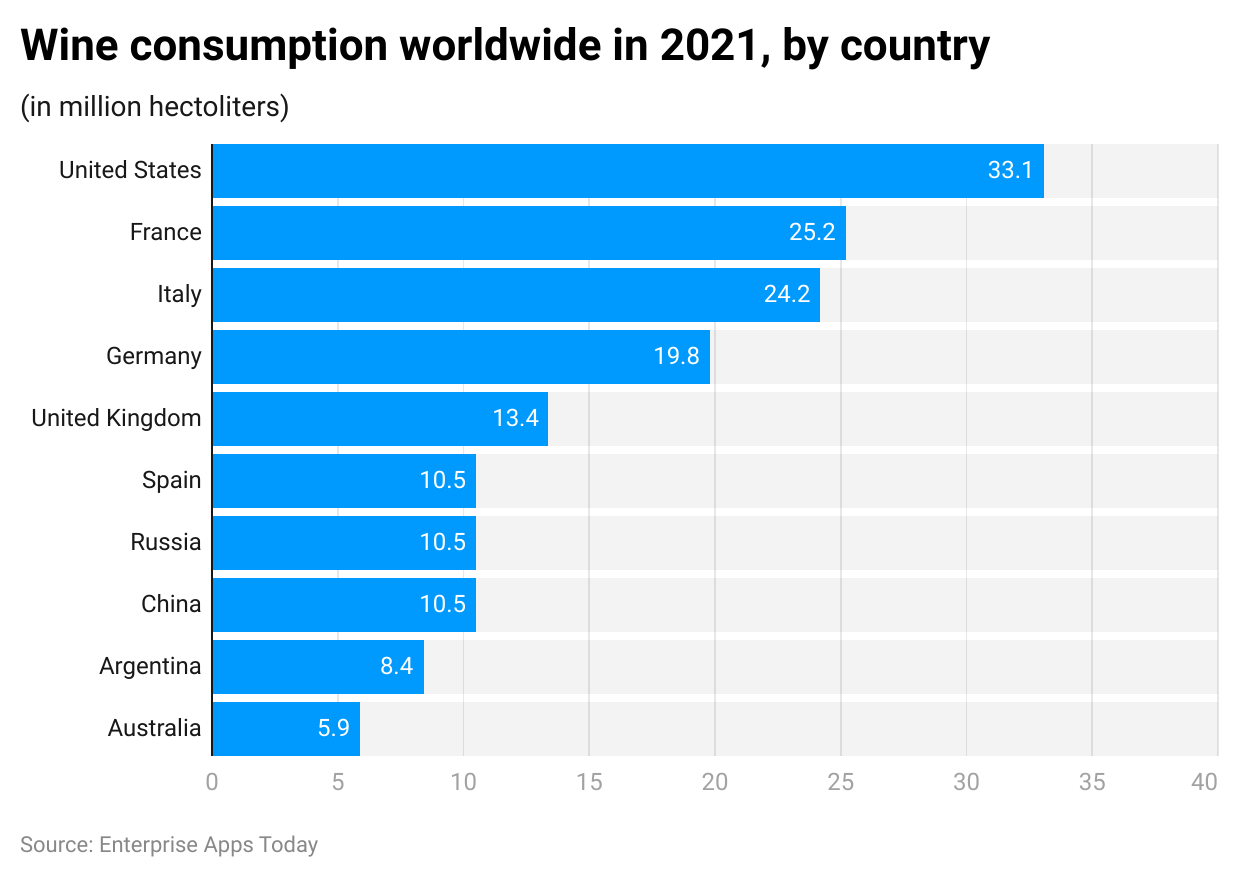 (Reference: Statista)
(Reference: Statista)
- According to Wine Industry statistics, the consumption of wine as of 2021 in the United States of America was the highest resulting in 33.1 million hectoliters.
- France has ranked second with 25.2 million HL drinks in the year 2021.
- Similarly, Italy ranked in third place with a recorded number of 24.2 million hl consumed wine.
- Other countries on the list of Wine consumption worldwide in 2021 are Germany (19.8 million hl), United Kingdom (13.4 million hl), Spain, Russia, China (10.5 million hl), Argentina (8.4 million hl), and Australia (5.9 million hl).
By Region
Africa
- The overall revenue of the Wine industry in the African market as of the year 2022 is around USD 8.29 billion.
- By the year 2025, the market is expected to grow at a CAGR of 14.26% by the year 2025.
- In the African market, considering the overall population market, Wine industry statistics say that there is USD 6.75 will be generated per person as of the year 2022.
- The African Wine market is 0.72 L per person counted as an average volume.
- By the year 2023, the Wine segment is expected to grow by 13.7%.
- The total out-of-home wine consumption such as in restaurants or bars is expected to be 31% of the spending and 12% of the volume consumption by the year 2025.
Asia
- The Wine industry statistics say that the Asian market amounts to USD 52.66 billion as of 2022.
- Whereas the market is expected to grow at CAGR 8.53% by the year 2025.
- The average amount of the per person volume is 0.59 L in the year 2022.
- The Asian wine market is expected to amount to 2,922 ML by the year 2025.
- As of 2023, Wine industry statistics say that the market is expected to grow at 5.3%
Americas
- The American Wine market is expected to grow at 5.3% by the year 2023. Furthermore, by the year 2025, it will volume to 7,097,3 ML.
- As of 2025, it is expected that out-of-home wine consumption will be 46% of spending and 20% of the volume consumption.
- The highest revenue is generated for the Wine market in the Americas amounting to USD 53,580 as of 2022.
- The overall Wine segment is expected to grow by VAGR 10.88% by the year 2025.
- In the American wine market as of 2022, on average, USD 85.92 is generated for per-person revenues considering the total population.
Europe
- By the year 2025, it is expected that the Wine segment in the European markets will amount to 15,365.6 ML.
- By the year 2023, the forecasted market growth rate is 11.4%.
- As of 2022, the average volume per person is 15.09 L.
- Comparing the total European population, per-person revenue in the Wine segment is USD 176.10 as of 2022.
- As of the year 2022, the Wine market amounts to USD 149.50 billion.
- As per the Wine industry statistics, the overall market is expected to be at CAGR 13.40% by the year 2025.
By Type
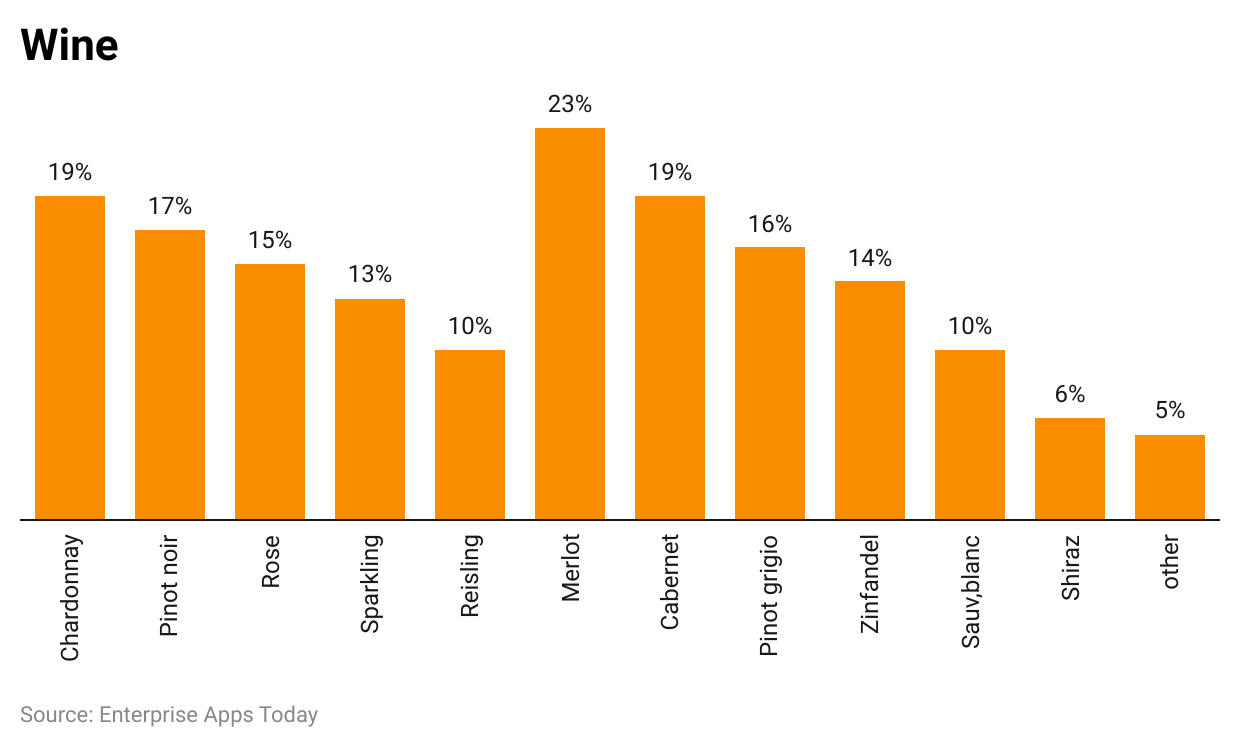 (Reference: Alcohol.org)
(Reference: Alcohol.org)
- As per the Wine industry statistics, there are various types of sub-categorized wines with overall consumption rates in the United States of America.
- The highest percentage of type of wine consumed is Merlot resulted in 23%.
- Whereas Chardonnay and Cabernet are consumed at 19% with similar rates.
- Pinot Noir and Pinot Grigio have a consumption rate of 17% and 16% respectively.
- Other than the above-mentioned types of wines, Rose, Zinfandel, and Sparkling wines are consumed at 15%, 14%, and 13% each in the United States of America.
- Other types such as Riesling, Sauv Blanc, and Shiraz have respective consumption rates of 10% and 6%.
- Other types of wines with negligible rates have around 5% of the consumption rate.
By Per Capita
| Country | |
|---|---|
| Portugal | 51.9 Liters per capita |
| France | 46.9 liters |
| Italy | 46 liters |
| Switzerland | 35.3 liters |
| Austria | 30.6 liters |
| Australia | 28.7 liters |
| Germany | 27.5 liters |
| Spain | 26.2 liters |
| Netherlands | 26.1 liters |
| Belgium | 26 liters |
(Source: decanter)
- As of the year 2021, Wine industry statistics say that Portugal ranked at the top for exporting maximum liters of Wine per capita resulting in 51.9 liters.
- In the same year, France exported around 46.9 liters of Wine around the globe.
- Italy and Switzerland exported around 46 liters and 35.3 liters respectively.
- Austria exported around 30.6 liters and Australia recorded around 28.7 liters of wine export in the year 2021.
- Similarly, With minor differences of liters other countries had a total export in the year 2021 as follows; Germany (27.5 liters), Spain (26.2 liters), Netherlands (26.1 liters), and Belgium (26 liters)
By Demographics
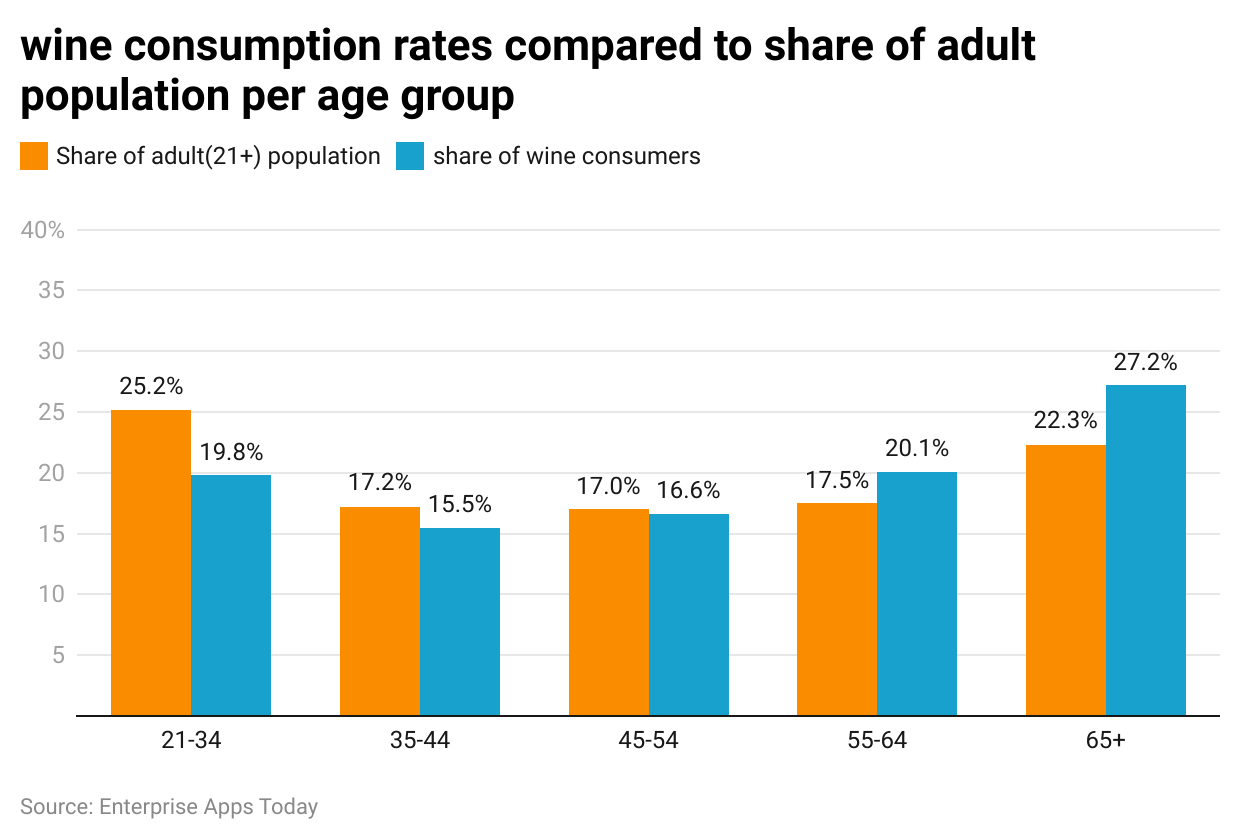
(Reference: svb.com)
- There are around 25.2% of the people in the age group of 21 years to 34 years. Out of which 19.8% are wine consumers.
- Moreover, 15.5% of the people from the age group of 35 years to 44 years of wine consumers belong to 17.2% of the people in the same age group.
- Furthermore, Wine industry statistics show that with a minor difference in the overall people and wine consumers in the age group of 45 years to 54 years are 17.0% and 16.6% respectively.
- There are around 17.5% (recorded )of the overall people from the age group of 55 years to 64 years out of which 20.1% share in wine consumers.
- The population aged 65 years and above is 22.3% in total but the recorded number of consumers who drink wine is 27.2%.
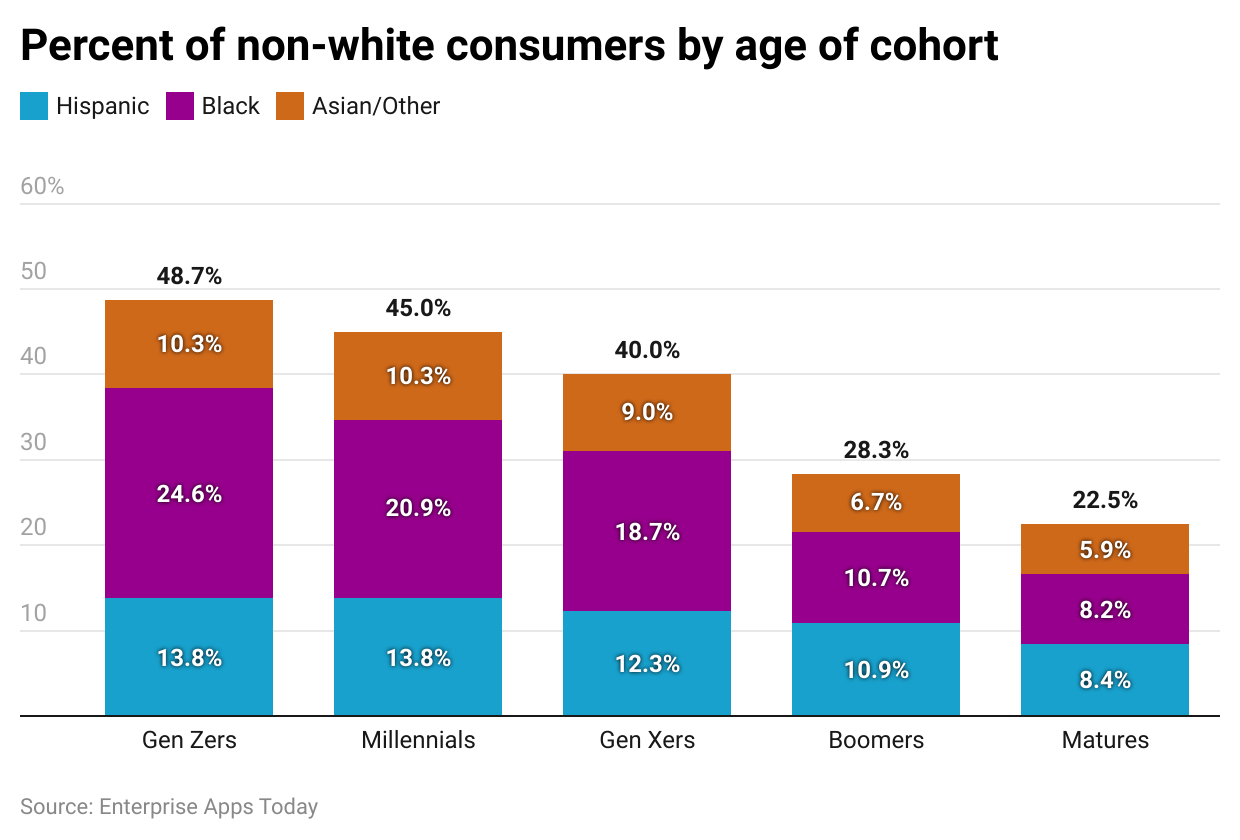
- Considering the age groups in various people of ethnicity groups present the above chart.
- There are Around 48.7% of Gen Z wine consumers further subcategorized into the 13.8% Hispanic population, 24.6% black population, and 10.3% Asian population.
- Similarly, there are overall 45.1% of millennials who drink wine divided further into Hispanic (13.8%), Black (20.9%), and Asian (10.3%).
- Gen X has around 40.2% of overall wine consumers out of which 12.6% are Hispanic, 18.7% are black and 9% are Asian.
- Population from baby boomers and matures have 10.9% and 8.4% Hispanic, 10.7% and 8.2% black, and 6.7% and 5.9% Asian respectively.
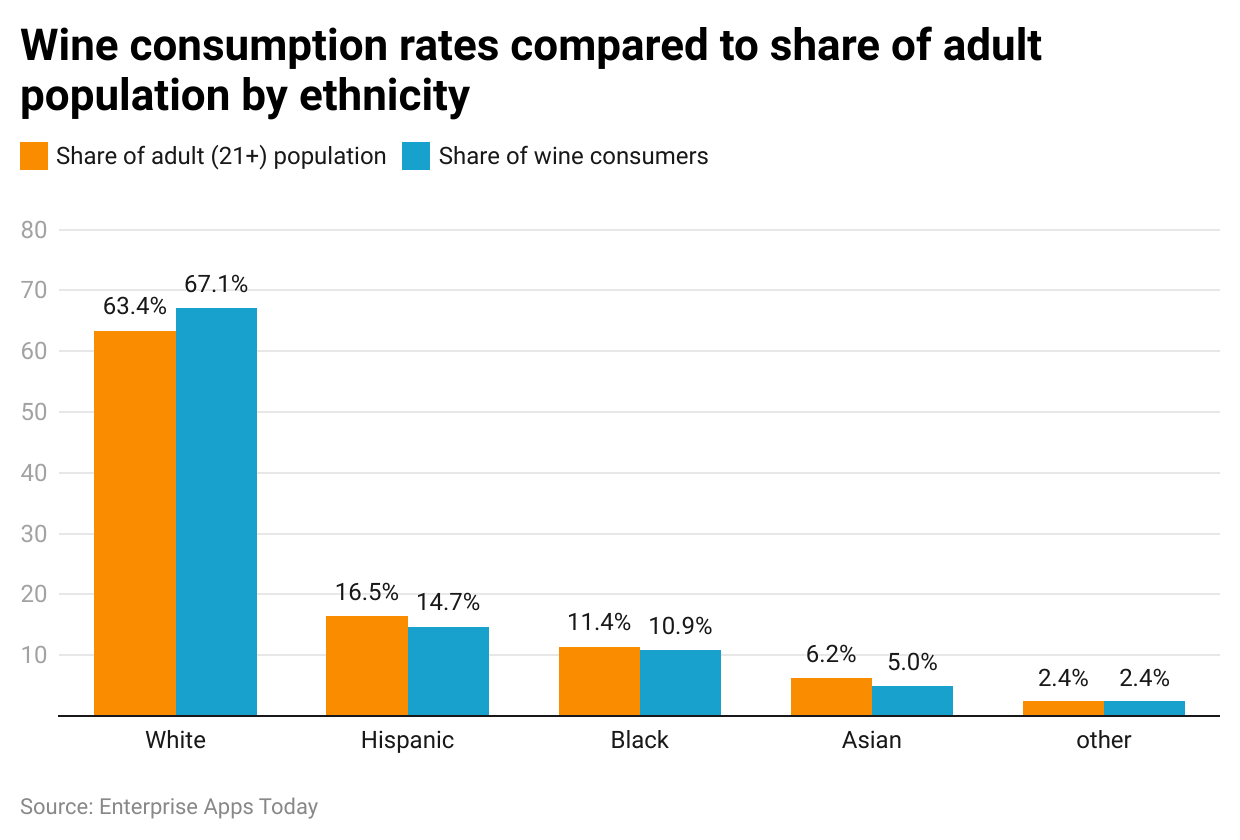 (Reference: Silicon Valley Bank)
(Reference: Silicon Valley Bank)
- The overall share of the adult population in the white people group is 63.4%. And there are 67% of wine consumers in the same group.
- Whereas Hispanic people and black people share around 16.5% and 11.4% of the adult population where 14.7% and 10.9% are wine drinkers respectively
- Asian people share is 6.2% and 5% are wine consumers.
- Other people in the population by ethnicity are similar in the share of the adult population and wine consumers resulting in 2.4%
By Coverage
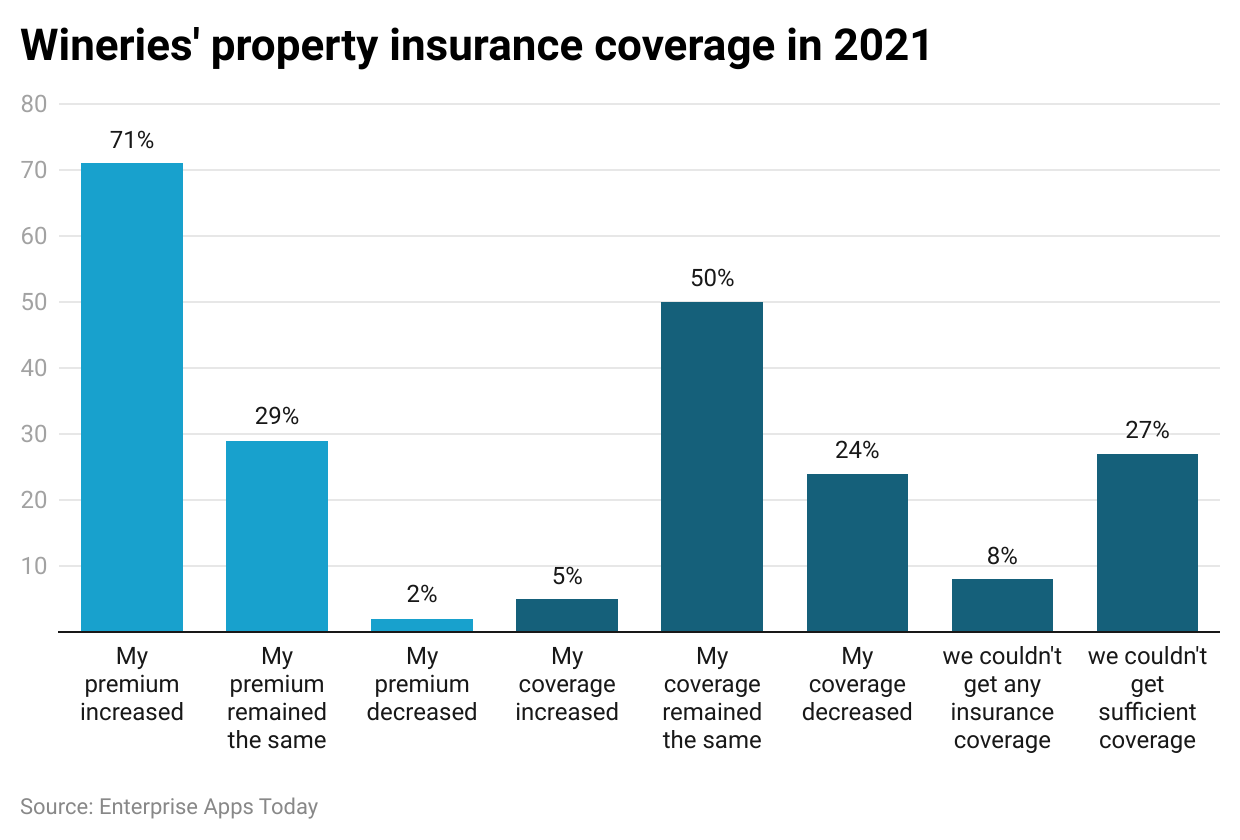
- As per the records from Wine industry statistics, in the year 2021, 71% of the people who took insurance coverage for their wineries said that their premium for the same had been increased.
- 29% of the people in the same category reported that their insurance premiums didn’t change.
- Furthermore, only 2% of the people said that their insurance premiums decreased.
- Considering the winery's insurance coverage, 5% of the people said to have their coverage increased.
- Whereas 50% of the people reported having their wineries insurance coverage remain the same.
- The remaining 24% and 8% said that their coverage decreased, and others couldn’t insure their wineries respectively.
- 27% of the people said their insurance coverage wasn’t enough for their wineries.
By Sales Channels
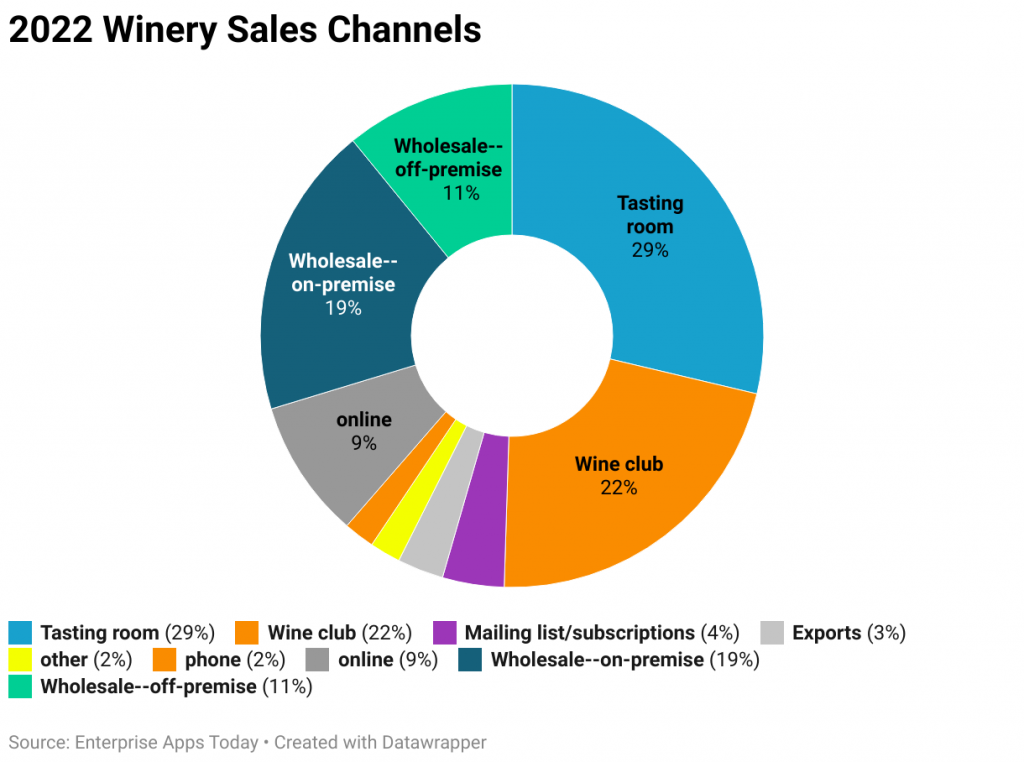
(Source: Silicon Valley Bank)
- The above chart shows the various ways of winery sales as of 2021. According to Wine industry statistics, the highest winery sale is employing tasting room resulting in 29%.
- Wine club recorded an overall 22% of the sales.
- Whereas digital sales such as from mailing lists or subscriptions account for up to 4%.
- Furthermore, other sale channels are exported phone, online, wholesale on-premise, and premise accounting for 3%, 2%, 9%, 19%, and 11% respectively.
- While other various means account for only 2% of the overall winery sales channel.
By Supplies
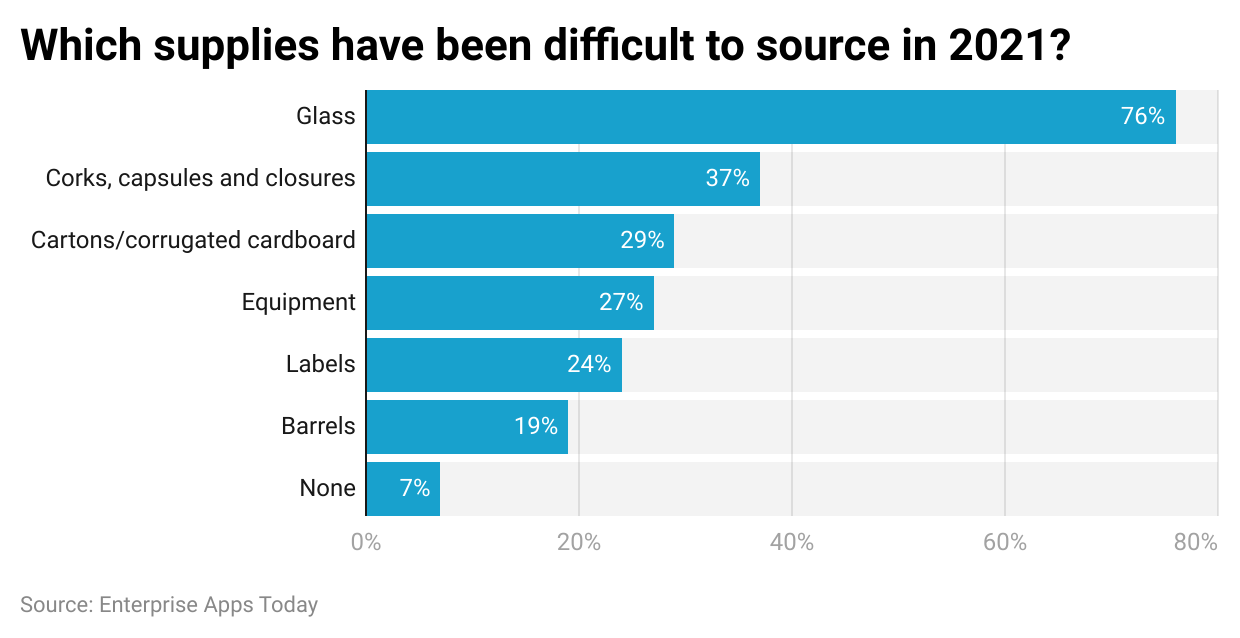 (source: svb)
(source: svb)
- Wine industry supplies as of the year 2021, glasses were the most chosen to be difficult to supply resulting in 76%.
- 37% in the same category belongs to corks, capsules, and closures.
- Cartons and corrugated cardboard recorded a difficulty rate of 29%.
- Other equipment required in wineries had a difficulty in supply by 27%.
- Label and Barrel were given 24% and 19% respectively.
- While 7% of people said there were no difficulties with the winery supplies.
Wines Industry Statistics For Wine
- Chardonnay is one of the most-sold white wine varieties across the U.S.
Chardonnay can be transformed into sparkling wines and sweet wines. It is a popular product in the U.S., it earned USD 2.549 billion in sales in the year 2019.
- Cab Sauvignon has been identified as the most-seller red wine variety sold across the U.S.
It's named after the grapes it's made of, Cabernet Sauvignon topped the charts of top-selling wines sold across the U.S. – white or red by a staggering USD 2.575 billion in sales for 2019.
- Barefoot Wines is the most popular wine brand across the U.S.
Barefoot, commonly referred to as a ‘table wine', recorded more than $664 million in revenue in 2021. The second most loved label, Sutter Home, had USD 425.3 million in sales the same year.
Barefoot is famous as a casual and inexpensive brand, as well as E&J Gallo owns it.
Trends In the Wine Industry
- The global wine market is expected to grow at a CAGR of 4.4% during the forecast period (2021-2026).
- Organic wine sales are expected to reach USD 49.5 billion by 2025, growing at a compound annual growth rate (CAGR) of 9.2%.
- The rosé wine category is projected to grow by 70% by 2024.
- Millennials account for 36% of wine-consuming adults in the United States in 2021.
- Red wine accounts for about 55% of the global wine market share.
- In 2021, the global wine packaging market was valued at approximately USD 22.66 billion and is expected to grow at a CAGR of 4.2% until 2026.
Recent Developments In the Wine Industry
- E-commerce sales represented 19% of global wine retail sales in 2020, up from 8% in 2019, indicating a significant shift towards online purchasing.
- Online wine sales have experienced a 198% growth in dollar value, demonstrating the increasing popularity of purchasing wine online.
- The global wine market reached a value of USD 326.53 billion in 2020, reflecting the industry's resilience and continued growth despite challenges such as the COVID-19 pandemic.
- Spain, with over 2.5 million acres of vineyards, maintains the most extensive vineyard area globally, highlighting its significant role in wine production.
- Australia, as the fourth-largest wine exporter globally, contributed 7% of the world’s total wine exports in recent years, showcasing its continued prominence in the industry.
Conclusion
In conclusion, the wine industry demonstrates robust growth and resilience, as evidenced by several key statistics. The global wine market, valued at USD 326.53 billion in 2020, continues to expand, with a forecasted CAGR of 4.4% through 2026. E-commerce sales, which represented 19% of global wine retail sales in 2020, have seen significant growth, soaring by 198% in dollar value. Spain stands out as a major player, boasting over 2.5 million acres of vineyards, while Australia contributes 7% of the world's total wine exports. These trends underscore the industry's adaptability and enduring appeal to consumers worldwide, making it a lucrative sector for investment and market analysis.
Sources
FAQ.
Domaine de la Romanee-Conti is the most expensive wine costing around $19,000 per bottle.
Wine was invented in Georgia in 6,000BC.
Penfolds Block 42 Kalimna Cabernet Sauvignon is the rarest wine in the global market.
Yes, red wine is healthy to drink but on a occasional level

Barry is a lover of everything technology. Figuring out how the software works and creating content to shed more light on the value it offers users is his favorite pastime. When not evaluating apps or programs, he's busy trying out new healthy recipes, doing yoga, meditating, or taking nature walks with his little one.